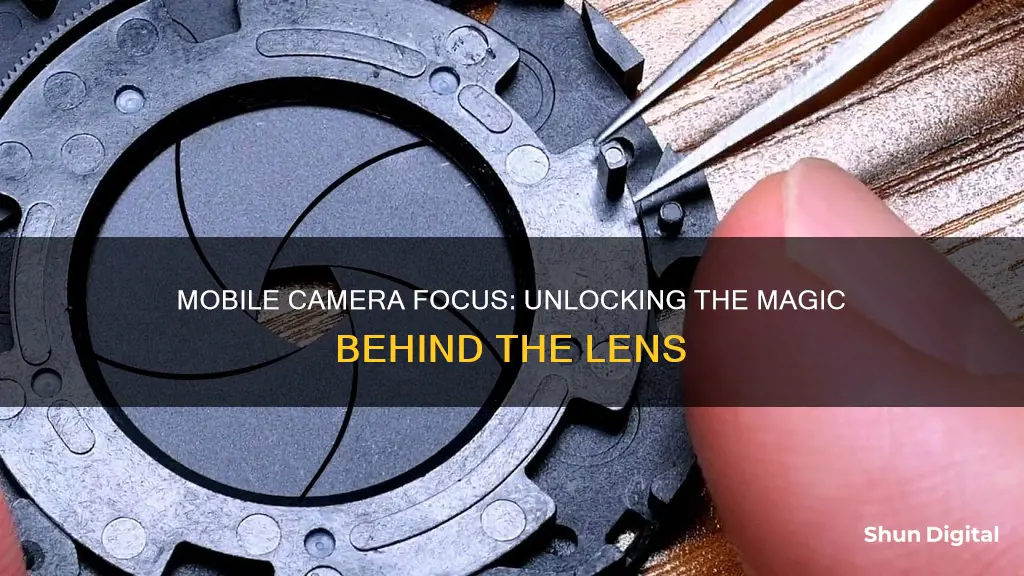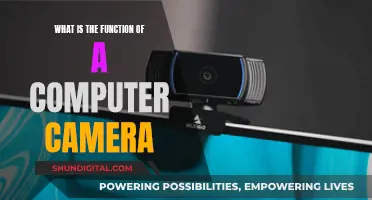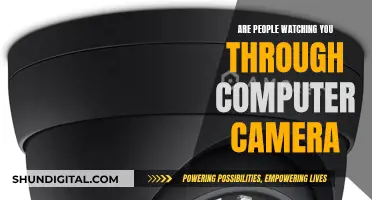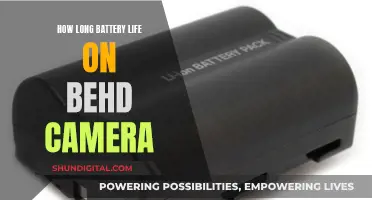
Getting the focus right is a big part of quality photography. Smartphone cameras have improved over time, and one aspect of this progress is the autofocus system. There are three methods for performing autofocus on a smartphone: contrast-detection autofocus, phase-detection autofocus, and laser autofocus. The first method, contrast-detection autofocus, is the most common and works by maximising the contrast between light and dark areas in a scene. Phase-detection autofocus is faster and more advanced, and is found on high-end smartphones. It works by comparing light from two apertures on opposite sides of the lens. The third method, laser autofocus, is the quickest and works by emitting a beam of infrared light to calculate the distance to an object.
What You'll Learn

Contrast-detection auto-focus
The system is based on the principle that the accurately focused image has the highest contrast among all images of the same scene. The camera's algorithm measures the contrast in the image, and when the level of contrast is highest, the image is in focus. When an image is out of focus, colours tend to blur into each other, resulting in a lower level of overall contrast.
The contrast-detection autofocusing system has a stop-start relationship with the camera lens. The system tells the lens to move focus, then stops to check the contrast of the image. This process is repeated until the image is in focus. The system will overshoot the point of best focus, but it will then wind back the focus to the point at which the contrast was at its best.
Contrast-detection autofocus is a common method in digital cameras that lack shutters and reflex mirrors. It is also used in mirrorless system cameras, as it can analyse the actual image being recorded by the camera's main sensor, reducing the chance of inaccuracy through mechanical misalignments.
The main drawbacks of contrast-detection autofocus are that it is reasonably slow, it doesn't always work in low-light conditions, and it cannot track moving objects.
Who Gets the Ticket? Speeding Camera Tickets Explained
You may want to see also

Phase-detection auto-focus
Phase-detection autofocus (PDAF) is a faster form of autofocus than the contrast-detection autofocus (CDAF) method. PDAF relies more on software and algorithms than on mechanically adjusting the lens position.
With PDAF, a small amount (roughly 10% or less) of the pixels on a sensor are set aside and embedded with a phase detection photodiode (a device on the image sensor that converts light into an electric current). These pixels are scattered across the sensor and receive light from either side of the lens. This is similar to how humans receive light separately through their left and right eyes to create one image in their brains.
The PDAF algorithm uses data from all the phase-detecting pixels spread across the sensor to determine if the image is in focus. If the data from the light waves gathered from the photodiodes match, then the light profile is in phase and the picture is in focus. If not, the light information captured by the photodiodes is used to determine the correct position of the lens to produce a sharp image. The focus motor then moves the lens to the right position, and this all happens in a fraction of a second.
PDAF is much faster than CDAF, making it ideal for moving objects or scenes with abrupt changes in distance. It can also track objects that are moving or changing direction, as it can measure their distance in every frame. However, like CDAF, PDAF relies on light coming through the lens, so it may take longer to analyse and focus in low-light conditions.
Modern PDAF systems, such as the Isocell HP2 image sensor on the Samsung Galaxy S23 Ultra, use 100% of the photosites on the image sensor, with top-facing and bottom-facing photosites in addition to left-facing and right-facing photosites.
Understanding P Mode: A Photographer's Creative Companion
You may want to see also

Laser auto-focus
However, laser auto-focus is only effective up to a certain distance, with a range of around 5m. Beyond this, the phone will switch to contrast-detection auto-focus. The laser can also be confused by reflective surfaces, such as windows, which can result in incorrect measurements. Additionally, this method is expensive and requires extra hardware, such as an infrared transmitter and receiver.
Is Your Camera Battery Charged? Check This Way
You may want to see also

Manual focus
To achieve manual focus on your smartphone, you'll need to download a third-party camera app that offers this feature. Not all stock camera apps provide manual focus capabilities. Some popular options include Open Camera, Camera FV-5, and ProShot. These apps will allow you to explore the benefits of manual focus and take your photography to the next level.
Once you've downloaded a suitable app, it's time to dive into the world of manual focus. Here's how you can do it:
- Open your chosen third-party camera app.
- Look for the option to enable manual focus. This could be a dedicated "Manual Focus" setting or a "Pro" or "Professional Mode" option.
- Enable manual focus by tapping on the setting or selecting it from a list of shooting modes.
- Compose your shot and determine what you want to be in focus.
- Use your finger to select the subject or area you want to focus on. Typically, you can tap and hold on the desired area to lock the focus.
- Adjust the focus as needed by following the app's specific instructions. This may involve sliding a focus slider or holding down the shutter button to move through the focus range.
- Once your subject is in focus, release your finger, and you're ready to capture the image.
History of Brownie Hawkeye Camera: When Was It Made?
You may want to see also

Active and passive auto-focus
Active and passive autofocus systems are two types of autofocus (AF) systems used in digital cameras. These systems help the camera focus on a subject or spot, ensuring sharp images without the need for manual adjustments. While active AF systems independently measure the distance to the subject, passive AF systems rely on analysing the incoming light and image.
Active Auto-Focus
Active AF systems utilise mechanisms such as infrared light or ultrasonic sound waves to determine the distance between the camera and the subject. By emitting an infrared light beam or ultrasonic sound waves towards the subject and calculating the time it takes for the signals to reflect back, the camera can adjust its optical system to achieve the correct focus. This method is particularly useful in low-light conditions as it does not depend on the light entering the camera. It is also beneficial for flash photography as it can measure distances in complete darkness.
However, active AF has some limitations. It may struggle with surfaces that absorb or reflect the infrared light, such as black surfaces or reflective objects. Additionally, it cannot focus through windows or transparent objects, as the sound waves and infrared light will be reflected. The accuracy of active AF systems is often lower than that of passive systems, and they may not be suitable for focusing on subjects very close to the camera.
Passive Auto-Focus
Passive AF systems, on the other hand, rely on the analysis of light and image contrast to determine the correct focus. They do not emit any energy towards the subject and instead use passive analysis techniques such as phase detection or contrast measurement. Phase detection involves dividing the incoming light into pairs of images and comparing their light intensity patterns to calculate the required focus adjustments. Contrast measurement, also known as contrast-detection AF, involves moving the lens back and forth until the position of maximum contrast is found, resulting in a sharp image.
Passive AF systems work well in most lighting conditions, especially when there is sufficient contrast in the scene. They are commonly used in digital single-lens reflex (DSLR) cameras and are known for their precision and speed. However, they may struggle in low-light or low-contrast situations, as they depend on the analysis of incoming light. Additionally, passive AF systems are generally slower than active systems due to the trial-and-error process involved in finding the optimal focus.
Trail Camera Battery Life: How Long Do They Last?
You may want to see also
Frequently asked questions
Autofocus is a feature that automatically sharpens the image and focuses on a specific spot or subject with little to no input from the user. It is important because it helps capture crisp and clear images by ensuring the light from the object is focused onto the sensor, creating a digitised image.
There are three main methods for autofocus: contrast-detection autofocus, phase-detection autofocus, and laser autofocus. Contrast-detection autofocus uses trial and error to find the point of maximum contrast and focus. Phase-detection autofocus is faster and more advanced, analysing light through the lens and comparing light from two apertures. Laser autofocus, on the other hand, is an active system that emits an infrared beam to calculate the distance to the object.
Contrast-detection autofocus is widely used as it doesn't require additional hardware, making it a cheap and easy option. However, it is slow and may not work well in low-light conditions or when tracking moving objects.
Phase-detection autofocus is a newer and faster method, commonly found on high-end smartphones. It can provide continuous autofocus and is ideal for capturing fast-moving scenes.
Similar to contrast-detection, phase-detection autofocus relies on analysing light and may struggle in low-light conditions. Additionally, it is currently available only on select high-end devices from specific manufacturers.







